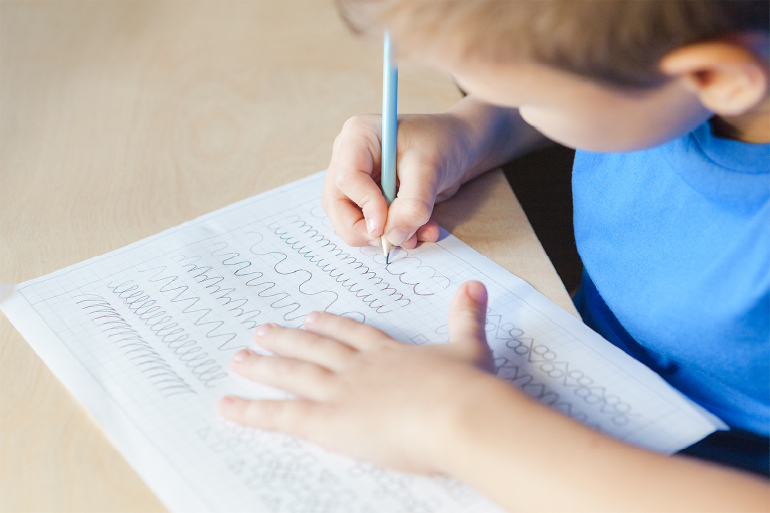
His handwriting is always cramped close together with no spacing…
The teacher complained that she writes illegibly…
She takes very long to learn the letters…
We have seen handwriting as one of the most common reasons for referrals to Occupational therapy. Handwriting is one of the most complex skills to learn and teach. However, many parents and teachers have often overlooked these underlying skills required in handwriting. The skill involves an intricate blend of sensory, visual perceptual, cognitive and motor abilities. Hence, this occupational task consists of many underlying components skills that may interfere with handwriting performance.
Occupational therapists use formal assessment tools and clinical observations to assess each handwriting component skill. They facilitate improved handwriting by using motor, postural, eye hand coordination, visual perceptual, and movement based interventions during Occupational Therapy sessions. It was evidenced that students with handwriting challenges who receive Occupational therapy have significantly more legible handwriting that those who do not (Case-Smith, 2002).
Handwriting development
The development of handwriting begins with early scribbling, which becomes more intentional with time. A child learns to print letters by first imitating geometric shapes. According to the first nine forms of the Developmental Test of Visual Motor Integration, in order of difficulty is as follows:
- Vertical line
- Horizontal line
- Circle
- Cross
- Right oblique line
- Square
- Left oblique line
- Oblique cross
- Triangle
(Beery,N., Buktenica,N. & Beery, K., 2010).
It is pertinent to be aware of your child’s handwriting skills to be able to provide them with the handwriting training suitable to their handwriting development for further progression. Practicing these pre-writing strokes and shapes is an important foundation for handwriting skills, as children learn to combine some of these strokes and shapes to form a letter.
Activities for pre-writing skills may include:
- Drawing lines and shapes on sand tray or shaving foam
- Forming shapes and letters using play dough or sticks
- Colouring activities using various materials such as crayons, chalk, paint
- Tracing patterns and shapes using a template
- Includes lots of tactile play e.g. finding objects in pasta box, body painting and playing with slime.
Gross Motor Skills
Gross motor skills include postural control, shoulder stability and muscle tone. Frequently, children lacking a stable trunk may experience fluctuations in muscle tone demonstrate poor handwriting. They are not able to sustain an upright position during the writing task. And without the stability of the shoulder, elbow and wrist, the speed and dexterity of the hand’s finer movements when manipulating the writing tool become affected. The efficient control of the bigger muscles in the neck, trunk and shoulder are very crucial for stability in the hand to complete a writing task.
Activities to improve gross motor skills may include:
- Lying down on the tummy during play time
- Using an easel board for drawing to work on shoulder stability
- Playground activities which include climbing ladders, slide and swings
- Sports activities such as swimming, dance and cycling
- Engaged in animal walks e.g. bear walk, frog jump, kangaroo jump and crab walk
- Participate in exercises like push-ups, sit-ups and planking
- Opportunities to be involved in household chores e.g. wiping the table, carrying groceries and mopping the floor.
Fine Motor skills
An important development for fine motor skills is bilateral hand use. This is when two hands are used together to manipulate or grasp objects. During writing, children need to stabilize the paper with their non-preferred hand while they write with their preferred hand.
Children usually establish their preferred hand use by the age of 4 to 6 years old. They may tend to switch hands when holding a pencil if they have not established their hand dominance or simply because their either hand feels fatigued from the writing task. With hand dominance, children could use their preferred hand even when doing tasks crossing the midline. For younger children, always present the item in midline so that the child can reach out with their hand (specially when their hand preference is not established yet). Do not try to put a crayon in their right hand just because it’s easier to teach a right-handed child. Always, get them to choose which hand to use and they will usually progressively become more consistent with their hand dominance.
Children also need to learn how to isolate their fingers from the palm in order to hold the pencil with their fingers. Initially, children might use the whole palm to hold the writing material, as they have not developed the hand control to isolate the fingers from their palm. As their gross motor develops and they experience more fine motor control, they will eventually develop a dynamic tripod grasp whereby they will use the first three fingers to hold the pencil.
Activities to develop fine motor skills include:
- Using squeeze bottles during art and craft to improve hand strength
- Using a dropper as part of a fun activity
- Finger painting
- Drawing on an easel board encourages crossing the midline
- Hammering toy helps in establishing hand dominance
- Playing with playdough to encourage molding, squeezing, pulling, or pinching is a great way to strengthen the hand muscles
- Lacing activities
- Using shorter chalk or crayon to encourage the use of 3 fingers
- To transfer coins or smaller objects from palm to fingers
- Playing with manipulative toys e.g. Lego, constructive toys and coin slotting
- Engaged in daily activities e.g. Using a spray bottle to help water the plants, squeezing a sponge during a shower, wringing a wet cloth, manipulating clothes pegs
Visual Perceptual Skills
Visual perception is the ability to process and organize visual information from the environment. A child with visual perceptual problems may present the following challenges in writing:
- Difficulty distinguishing between similar shapes e.g., circle/oval, square/triangle
- Confusion with similar letter symbols e.g., u/v; p/q/g
- Reverses letters and numbers e.g., b/d
- Omits or repeating words written when copying
- Difficulty copying from the board
- Poor judgment of spacing in writing
- Reads from right to left for e.g., saw for was, tap for pat
- Slow speed in writing
Activities for visual perceptual skills:
- Matching and sorting activities
- Puzzles
- Connecting dots or tracing worksheets
- Hidden picture games
- Spot the Difference!
- Eye tracking exercises e.g. to follow an object in various directions
- Writing letters in the air using various body parts
- Multisensorial writing on different medium such as paint, salt tray, sand tray and shaving foam
- Origami which involves folding of paper to form an art
- Participate in household activities such as folding clothes, sorting cutlery and laundry
- Provide appropriate writing materials e.g. pencil grips or lined papers
Cognitive Skills
Cognitive skills comprises of skills such as attention, memory, sequencing, and language comprehension, that is crucial in writing. The child needs to maintain his or her attention when learning handwriting skills and to be able to attend and complete any writing task given. In the area of memory, the child would need to remember how to write a letter and it is essential when he or she learns the sequence of letters for correct spelling of words. Language comprehension is important when the child is able to grasp the meaning of a sentence, paragraph or even a story so as to perform higher functional level of writing skills.
Activities for cognitive skills may include:
- Introduce fun activities to introduce shapes and letters e.g., form the letter “H” with 2 long sticks and one short stick
- Increase the awareness of patterns and sequencing e.g. red blue green red blue ______. Use toys or objects for younger children.
- Include songs to develop understanding of ABC sequence
- Establish concepts such as same and different through sorting or matching activities
- Play memory games
- Follow a sequence of instructions. The number of steps could be increased gradually according to the child’s ability.
Sensory Integration
This is a component skill that has often been missed out by parents. A child with dysfunction in sensory integration may have trouble regulating his or her arousal level. For instance, a child who is over-responsive to the stimuli from his environment would always be “on the go” and will not be able to attend to any writing lesson or writing tasks given. These stimuli may be the background noise made by other students or the visual distractions of objects on the writing table. He or she is too overwhelmed by the sensory stimuli received and is not able to focus on any class activity. This occurs when the brain of an over-responsive child is not able to filter the irrelevant stimuli from the environment. On the other hand, a child who is under-responsive may not be able to receive the stimuli given i.e., during a writing lesson, is not able to reach the optimal arousal level to attend to the activity.
One of the sensory systems is proprioception. Proprioception helps to tell us our sense of body position with receptors in our muscles, joints and tendon. Children with poor proprioceptive perception will result in fluctuating pressure of the pencil grips (sometimes too hard or too light). Also, they will feel that their hand fatigue easily if they could not grade their force and press too hard all the time. They may rely on their visual to look at how their hand moves while writing. These result in them writing too slowly and hence lack automaticity.
Good sensory integration will lead to good praxis skills. Praxis consists of mainly 3 stages:
- Ideation – having ideas and knowing what to do
- Motor Planning – planning a sequence of actions i.e. knowing how to do it
- Execution – carrying out the planned sequence in a smooth process
Children with poor praxis skills may present the following:
- Poor organisation and use of space on the page
- Poor performance on timed tasks
- Difficulty learning correct letter formation
- Poor legibility of the letters
General sensory and motor strategies to prepare a child for writing tasks:
- Give movement breaks during writing tasks so as to increase their alertness and attention. Movement breaks include water breaks, simple stretches, and exercises on chair.
- Treasure hunt box to find object without looking at it. This is to enhance the child’s tactile discrimination of different objects. Getting the child to find a specific object from his pocket could also work.
- Provide a “Sit & move” disc or gym ball so as to provide movement during sitting at the table.
- Giving hand massages which include deep pressure and joint compression to prepare the hands for a writing task.
- Use a variety of writing materials e.g. chalk, crayon or pencil as it provides more feedback compared to markers.
- Engage in sports such as basketball, soccer, tennis and baseball, which involve lots of heavy work, coordination, timing and sequencing.
- Include exercises that require attention and motor planning skills e.g. skipping ropes, jumping jacks and animal walks.
Other General Strategies
- Engage in playground or sports activities to develop the bigger muscles that are a great foundation for fine motor skills development.
- Ensure that the table is clutter free and preferably facing a plain wall to reduce any visual distractions.
- Focus on the quality first, then work on the quantity of writing tasks later.
- Break a long writing task into smaller chunks if needed.
- Allow the child to perform challenging writing tasks in a quiet environment.
- Ensure upright positions during writing. For good writing position, child’s feet should be on the ground with knees and hips at 90 degrees.
You should now have a better understanding of the challenges and underlying issues that your child may face in handwriting. Please do not hesitate to consult your occupational therapists to have a better understanding on the underlying concerns and for strategies to improve your child’s handwriting!
References:
Beery,N., Buktenica,N. & Beery, K. (2010). Beery-Buktenica Developmental Test of Visual-Motor Integration, Sixth Edition. Pearson, Bloomington.
Case-Smith, J. (2002). Effectiveness of school-based occupational therapy intervention on handwriting. American Journal of Occupational Therapy, 56, 17–25.
Chu, S.(1997). Occupational therapy for children with handwriting difficulties. British Journal of Occupational Therapy, 60(12), 514-520.
Taras, H., Brennan, J., Gilbert, A., & Eck Reed, H. (2011). Effectiveness of occupational therapy strategies for teaching handwriting skills to kindergarten children. Journal of Occupational Therapy, Schools, & Early Intervention, 4(3-4), 236–246.




